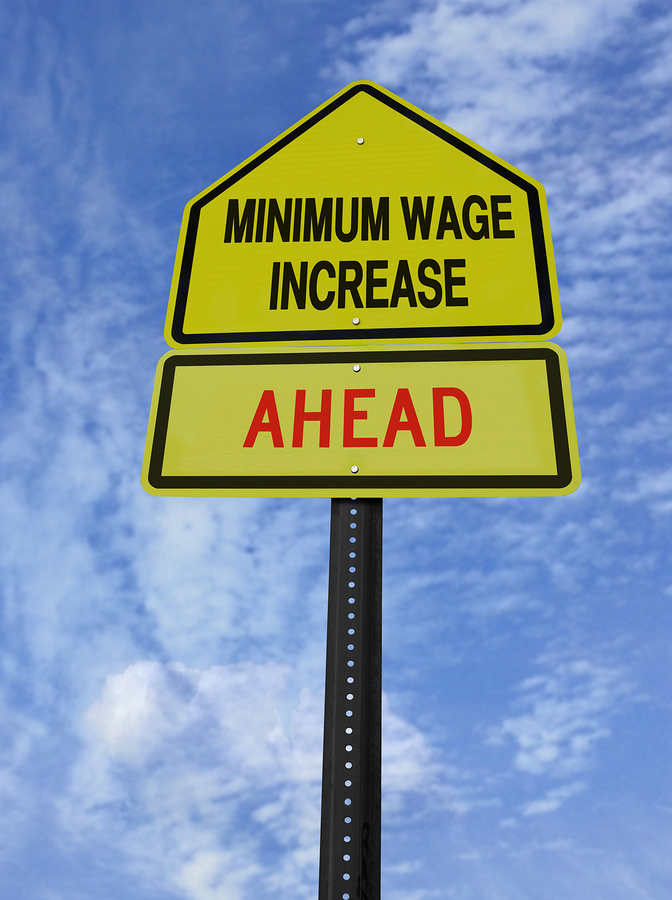Over the last two years, a combination of activity has led to increased interest in raising the minimum wage. Union-backed labor actions have arisen, aimed at fast food chains and companies such as Wal-Mart, while escalating concerns over growing wage inequality have sparked discussion in Congress. A group of Democrats calling for a new floor of $10.10 per hour is pushing the issue, and even some conservatives have called for higher minimum wages to keep companies from effectively socializing the costs of doing business while raising taxes and expenses for everyone else.

By the end of 2013, 13 states had raised their minimum wage, making it 21 states in total that now demand their employers to pay more than the $7.25 required by the federal government. And President Barack Obama has signed an executive order to increase the minimum wage for federal contractors and subcontractors to $10.10 by 2015, with regular annual increases starting in 2016.
Some people are worried that raising the minimum wage will affect middle market companies, hurting their chances for growth and increasing operational and strategic pressures. Before taking action, or breaking out in full-blown worry, business executives should look at the extent of the issue and the mix of impacts that it could have.
How Real Is the Issue?
Before anything else, consider whether a minimum-wage hike will directly affect your business. If your company is not a federal contractor or subcontractor, the executive order will have no direct impact. A future administration could also rescind the order.
Although many are trying to pressure Congress to increase the federal minimum wage, the political dynamics suggest that it is highly unlikely. Both the Senate and the House would have to pass such a measure. Absent a significant change in favor of Democrats in House midterm elections, a Republican-controlled House would likely oppose raising the minimum wage and halt the process, at least over the near future.
The state changes are real and will affect local minimum-pay levels, depending on where your company operates. The highest, at $9.32 an hour, is currently in Washington State, although Connecticut will raise its minimum wage to $10.10 by 2017. Missouri just raised its rate to $7.50. In other words, expect a patchwork of minimum-wage ranges by geography.
Downsides
There are certainly potential negative impacts resulting from minimum-wage increases. Companies that pay minimum wages will of course find their labor costs increasing. These businesses often depend on the low rates to help subsidize their operational models, so they could feel pain at the profit line. Companies that pay somewhat more than minimum wage could find that a sharp enough increase might put some employees into the minimum-wage category.
Companies that pay above minimum wage may also feel indirect pressure. For example, employees would be aware of an increase in minimum wage, which then leaves them making less in comparison. Although most people should understand that they aren't suddenly making less, there could still be an emotional perception that could affect hiring and existing salary negotiations. The smaller the gap, the more competition there is for employees, because people have a wider selection of jobs that pay around the same.
A business with union employees might run into more than a perception problem. Many union contracts include a wage-elevation clause tied to raising the minimum wage. If either the federal or applicable state level increases, so might the existing union rates.
There are other wage-related cost increases. FICA taxes proportionately increase with any rise in wages. There may be other benefits, including 401(k) contributions, pensions, and life insurance, that may be pegged to compensation.
In addition, some states or even municipalities that have raised their respective minimum wages are providing exceptions for small companies. That could mean increased competition for middle market companies from smaller competitors who would have lower overhead costs.
Upsides
So far, the possibilities seem completely negative, but a one-sided analysis can cause bad decisions. With all the complaining about minimum-wage hikes over the years and all the predictions of job destruction, companies have still gone on to do well.
Some of the apparent negative factors also come with benefits. Small companies with minimum-wage exceptions that were competing with middle market companies would find the competition for acquiring the best talent to be difficult. Many better employees would seek higher wages elsewhere, forcing the small employers to either let workers with the best expertise and ability leave or to pay valued workers more. This would effectively force these small companies to meet greater compensation levels in order to avoid a competitive disadvantage.
Putting more money in the hands of consumers, who will then go on to spend more, has its advantages. Much of the strong consumer resistance to price increasing has likely been a result of feeling the economic pressure of recent years. Relieve that pressure, and it might be possible to raise prices the fraction necessary to make up for any increase in labor costs.
Whatever factors come into play, avoid a knee-jerk reaction that's out of proportion with the challenge. Germany provides an example of a measured response, where businesses are beginning to back a minimum-wage plan because they will have enough time to plan and react. Rather than taking an all-or-nothing approach when social and political initiatives begin to mass, recognize that sometimes the best response is to figure out how to sail with the prevailing winds and currents.
Have thoughts on this issue? Let us know what you think by commenting below.
Erik Sherman is an NCMM contributor and author whose work has appeared in such publications as The Wall Street Journal, The New York Times Magazine, Newsweek, the Financial Times, Chief Executive, Inc., and Fortune. He also blogs for CBS MoneyWatch. Sherman has extensive experience in corporate communications consulting and is the author or co-author of 10 books. Follow him on Twitter.